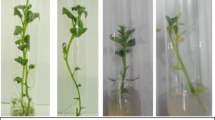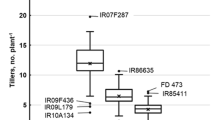Summary
Salt-tolerance in potato (Solanum tuberosum L.) was selected on the basis of germination and survival of seed sown in trays of perlite suspended in either 75 or 150 mM NaCl. Salinity reduced the germination of seed. Genetic differences in salt-tolerance were apparent with salt reducing germination more in seed collected from cv. Cara than in that collected from cv. Maris Piper. Progeny from the seedling selection were then grown to maturity to produce tubers.
The relative tolerance of the parental cultivars and of unselected and selected progeny to long-term exposure to salinity was examined in a pot experiment in which plants were irrigated with either fresh water or 50 mM NaCl solution from one week after plant emergence. In this experiment, salinity significantly reduced leaf conductance, total dry matter production and partitioning of assimilate to tubers. Salinity reduced dry matter production and assimilate partitioning to tubers to a greater extent in Cara than in M. Piper. Progeny selected for short-term salt-tolerance did not exhibit greater long-term salt-tolerance than unselected progeny, and both were more sensitive than M. Piper.
These results demonstrate genetic variation in salt-tolerance in potato. However, although there was a correlation between the performance of the parent to long-term salinity and survival of progeny in the seedling selection, there was no correlation between short- and long-term salt-tolerance. This suggests that characters underlying short-term tolerance may contribute to long-term tolerance but do not of themselves confer long-term tolerance. Future progress in selecting for improved salt-tolerance depends on understanding the effects of salinity on the physiological processes underlying growth and carbon partitioning.
Similar content being viewed by others
References
Al-KhatibM., T.McNeilly & J.C.Collins, 1993. The potential of selection and breeding for improved salt tolerance in lucerne (Medicago sativa L.). Euphytica 65: 43–51.
AllenS.G., A.K.Dobrenz, M.H.Schonhorst & J.E.Stoner, 1985. Heritability of NaCl tolerance in germinating alfalfa seeds. Agronomy Journal 77: 99–101.
AshrafM., T.McNeilly & A.D.Bradshaw 1987. Selection and heritability of tolerance to sodium chloride in four forage species. Crop Science 27: 232–234.
BilskiJ.J., D.C.Nelson & R.C.Conlon 1988. Response of six wild potato species to chloride and sulfate salinity. American Potato Journal 65: 605–612.
BrunsS. & K.Caesar, 1990. Sproßentwicklung und knollenerträge mehrerer kartoffelsorten bei hohen salzkonzentrationen au verschiedenen entwicklungsstadien. Potato Research 33: 23–32.
CuarteroJ., A.R.Yeo, & T.J.flowers 1992. Selection of donors for salt-tolerance in tomato using physiological traits. New Phytologist 121: 63–69.
EpsteinE. 1985. Salt-tolerant crops: origins, development, and prospects of the concept. Plant and Soil 89: 187–198.
GrieveC.M. & L.E.Francois 1992. The importance of initial seed size in wheat plant response to salinity. Plant and Soil 147: 197–205.
JefferiesR.A. 1993. Responses of potato genotypes to drought. I. Expansion of individual leaves and osmotic adjustment. Annals of Applied Biology 122: 93–104.
LevyD. 1992. The response of potatoes (Solanum tuberosum L.) to salinity: plant growth and tuber yields in the arid desert of Israel. Annals of Applied Biology 120: 547–555.
LevyD., E.Fogelman, & Y.Itzhak 1988. The effect of water salinity on potatoes (Solanum tuberosum L.): physiological indices and yielding capacity. Potato Research 31: 601–610.
McCreeK.J. 1986. Whole-plant carbon balance during osmotic adjustment to drought and salinity stress. Australian Journal of Plant Physiology 13: 33–43.
MeiriA. & Z.Plaut, 1985. Crop production and management under saline conditions. Plant and Soil 89: 253–271.
MohteithJ.L., G.S.Campbell, & E.A.Potter, 1988. Theory and performance of a dynamic diffusion porometer. Agricultural and Forest Meteorology 44: 27–38.
MunnsR. 1993. Physiological processes limiting growth in saline soils: some dogmas and hypotheses. Plant, Cell and Environment 16: 15–24.
MunnsR. & A.Termaat, 1986. Whole-plant responses to salinity. Australian Journal of Plant Physiology 13: 143–160.
RichardsR.A. 1992. Increasing salinity tolerance of grain crops: Is it worthwhile? Plant and Soil 146: 89–98.
SaxenaN.P., M.C.Saxena, P.Ruckenbauer, R.S.Rana, M.M.El-Fouly, & R.Shabana, 1994. Screening techniques and sources of tolerance to salinity and mineral nutrient imbalances in cool season legumes. Euphytica 73: 85–93.
VosJ. & J.Groenwold, 1988. Water relations of potato leaves. I. Diurnal changes in the canopy, the effects of leaf insertion number, cultivar and drought. Annals of Botany 62: 363–371.
YeoA.R., M.E.Yeo, S.A.Flowers, & T.J.Flowers, 1990. Screening rice (Oryza sativa L.) genotypes for physiological characters contributing to salinity resistance and their relationship to overall performance. Theoretical and Applied Genetics 79: 377–384.
Author information
Authors and Affiliations
Rights and permissions
About this article
Cite this article
Jefferies, R.A. Evaluation of seedling selection for salinity tolerance in potato (Solanum tuberosum L.). Euphytica 88, 207–213 (1996). https://doi.org/10.1007/BF00023892
Received:
Accepted:
Issue Date:
DOI: https://doi.org/10.1007/BF00023892




